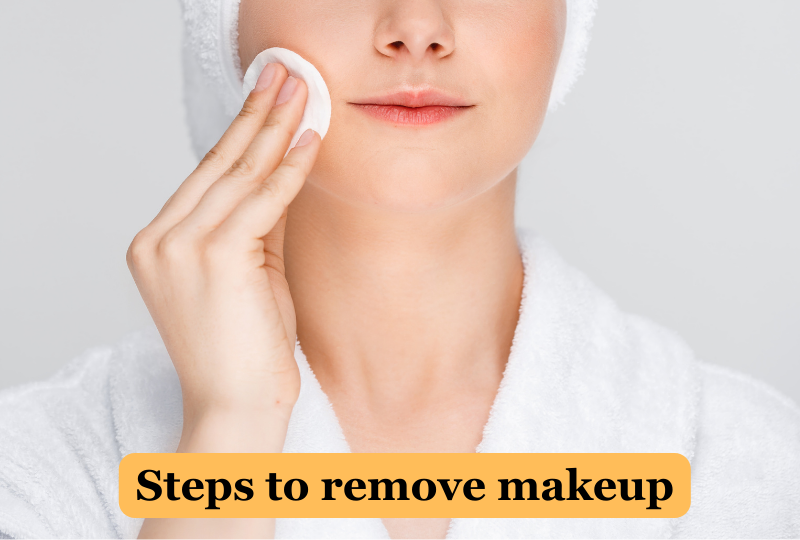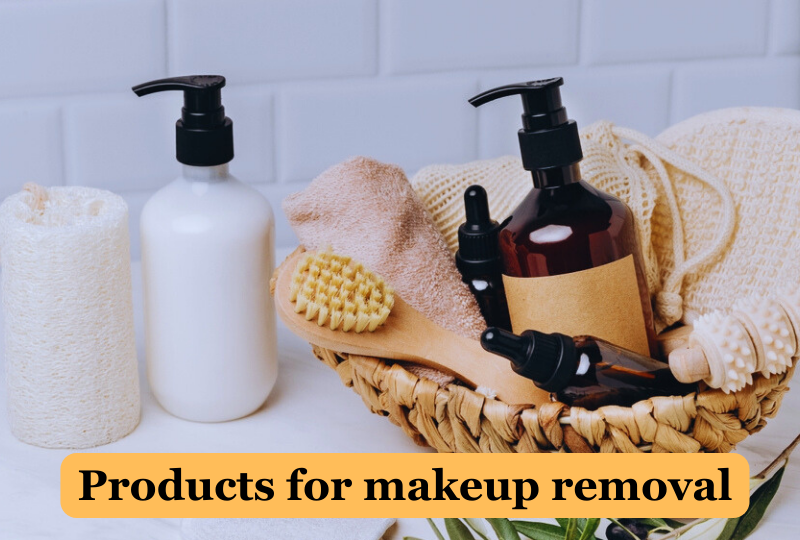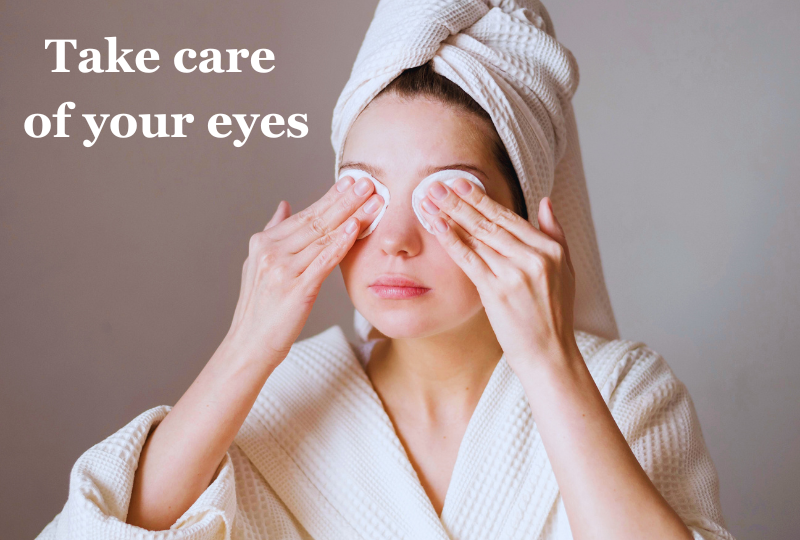Physical Address
304 North Cardinal St.
Dorchester Center, MA 02124
Physical Address
304 North Cardinal St.
Dorchester Center, MA 02124

Here In this article, We discuss about steps to remove makeup.
Everyone enjoys beginning again. You should definitely take off all your makeup if you want to have clear, radiant skin when you wake up. By taking off your makeup at night, you’re doing your skin a favor. Even merely wearing facial makeup while you sleep can create wrinkles from the breakdown of collagen, dry skin, and acne. The effects of leaving eye makeup behind include eye infections, eye discomfort, styes, and damaged eyelashes. For skin maintenance, removing makeup at night is essential.
Fortunately, we’ve developed a quick makeup removal procedure to enable you to awaken with refreshed and content skin.
Although going to bed without applying makeup won’t actually suffocate your skin because your skin doesn’t breathe, it may be worse for your pillowcases than it is for your skin. Theoretically, wearing makeup for extended periods of time ought to be problematic if it clogs pores.
Make sure that none of your beauty items are contributing to acne. Even while it’s not a guarantee, it’s best to stick with items that are described as “non-comedogenic,” “non-acidic,” “doesn’t clog pores,” or “doesn’t cause acne.”
Waterproof eye makeup in particular can be challenging to remove from the delicate skin around the eyes. Here are a few frequent blunders people make when taking off eye makeup:
1. Excessive scrubbing
The skin around the eyes is the thinnest and most sensitive on the face, and excessive exfoliating can cause irritation and early aging. When removing eye makeup, use gentle circular strokes and let your makeup remover or facial cleanser do the work rather than exfoliating your skin.
2. Not giving removers adequate time to work
It takes time for your facial cleanser or washing water to penetrate your skin and remove eye makeup, particularly waterproof mascara and eyeliner. When removing eye makeup, give the makeup remover at least 10 seconds on your skin before gently wiping it away.
3. Utilizing harsh skin care products
You may believe that if a product causes your skin to tingle, it is functioning. But carbonated goods frequently indicate that your skin has responded poorly to the active ingredients, which could result in irritation or acne. Pick makeup removers that don’t cause irritation or burning when used.

A. Cleaning supplies
Cleansers, particularly water-based cleansers, are inappropriate for removing makeup on oneself. We strongly advise using the double cleansing technique because it removes makeup the best. After cleansing your face to get rid of oil-based pollutants and makeup, wash your face twice. Choosing a cleanser with oils, such coconut oil, makes sure that any lingering residue or makeup traces are almost completely gone.
B. Makeup Remover
The majority of makeup removers available today come in the shape of wipes, which is, to put it bluntly, not the ideal choice. Customers are encouraged to assume that you can just clean yourself and go to sleep after using products that are frequently promoted as a one-step method of removing makeup without rinsing. But the opposite is actually true. Wipes for removing makeup are ineffective in cleansing the skin. But you can use a dual-purpose pre-moistened towel to spread debris, oil, makeup, and dead skin over your face:
Reusing makeup remover wipes can cause things like minor irritation, clogged pores, and accelerated aging because of all the friction and dubious substances (such as alcohol, strong cleansers, parabens, etc.). Consequently, we advise that you discard the towels. Eliminating the “makeup remover” entirely is preferable.
C. Micellar water
A facial cleanser called micellar water is based on microscopic micelles, or tiny clusters of surfactant molecules. Each molecule has a side that is drawn to the oil, which attracts oil-based contaminants like makeup to be removed. Since the other side is drawn to water, micellar water can be used to wash or clean surfaces.
Their molecular make-up-removing abilities are enhanced by their lightweight water-based solution, which is perfect for those with oily skin or those who prefer to look more natural without wearing a lot of makeup. Additionally, they are kinder than conventional makeup removers and frequently include less harmful components. Try micellar water if you don’t wear a lot of makeup and prefer a quick method of makeup removal.
Step 1: Wash your hands
It is the first important steps to remove makeup properly. To stop microorganisms from your fingers touching your face, carefully wash your hands before removing your makeup. Use warm water and soap, then dry your hands.
Step 2: Treat your skin gently
Always remove makeup as completely as you can to prevent skin irritability or dryness. Your face should be cleaned with a calming cleansing oil before you wait a while for the makeup to disappear. After that, simply run a cotton pad soaked in washing oil over your face to remove makeup. No friction is required!
Step 3: Apply cleaners
With a detergent, blush and foundation are simple to remove. It only requires rubbing the cleanser onto your skin, waiting fifteen seconds, and then wiping it off with water.
Step 4: Take pleasure in the steam’s warmth
Before washing, you can also spritz your face. Point your face at a bowl or sink filled with hot water for a minute or two. The cleanser can more easily go deeper into the face to eliminate debris and makeup since the steam hydrates the pores. Although it takes more time to spray the skin, it is a suitable alternative for a casual setting.

Step 5: Take care of your eyes
The last thing you should remember is that your sensitive eye area needs cautious, uncompromised treatment. Even if you don’t want to use coconut oil on your entire face, we think it’s the best makeup remover for eyes because it helps to preserve and protect the delicate skin around your eyes. Whatever you do, keep your skin smooth to the touch and avoid rubbing your eyes. Apply an anti-aging eye lotion after you’ve thoroughly cleaned and makeup-free your eyes.
Step 6: Take off extra makeup
It is the last steps to remove makeup. Make a second pass with a dry cotton pad after removing the eye makeup to ensure that all traces of the makeup and extra makeup remover have been eliminated. This final sweep helps with makeup application the following day and prevents mascara circles in the morning. Nobody enjoys having raccoon eyes when they awaken.
Step 7: Skip baby wipes
Makeup removal often involves the usage of baby wipes. They won’t hurt you, for sure, but they aren’t made to dissolve the oils that accumulate on grownups’ faces. Use of conventional makeup removal pads is recommended.
Step 8: Apply skin moisturizer
After all the steps to remove makeup, at the end apply moisturizer. To restore your skin’s natural moisture, use a moisturizer, hydrating toner, or serum. The skin of the face becomes supple and silky when moisturized.
Is it acceptable to remove makeup using baby oil?
Yes, baby oil removes makeup gently and efficiently. But remember to thoroughly rinse your face after use.
How frequently should I scrub my skin?
Generally, exfoliating once or twice a week is advised, however this might vary depending on your skin type. Adapt the frequency to your skin’s need.
If my skin is greasy, may I forgo the moisturizer?
No, oily skin requires moisture as well. If you have oily skin, look for gel-based or oil-free moisturizers.
What exactly does “double cleaning” entail, and is it necessary?
Double cleansing entails using a conventional facial cleanser first, then a makeup remover or cleansing oil. This will guarantee that your skin is free of pollutants and makeup. It can be useful even though it’s not always essential, especially if you’re wearing a lot of makeup.
When removing my makeup at night, do I still need to use sunscreen?
No, sunscreen should only be used in the daylight hours to shield the skin from UV rays. You don’t need it at night.
Resource Health
[…] steps to remove makeup […]